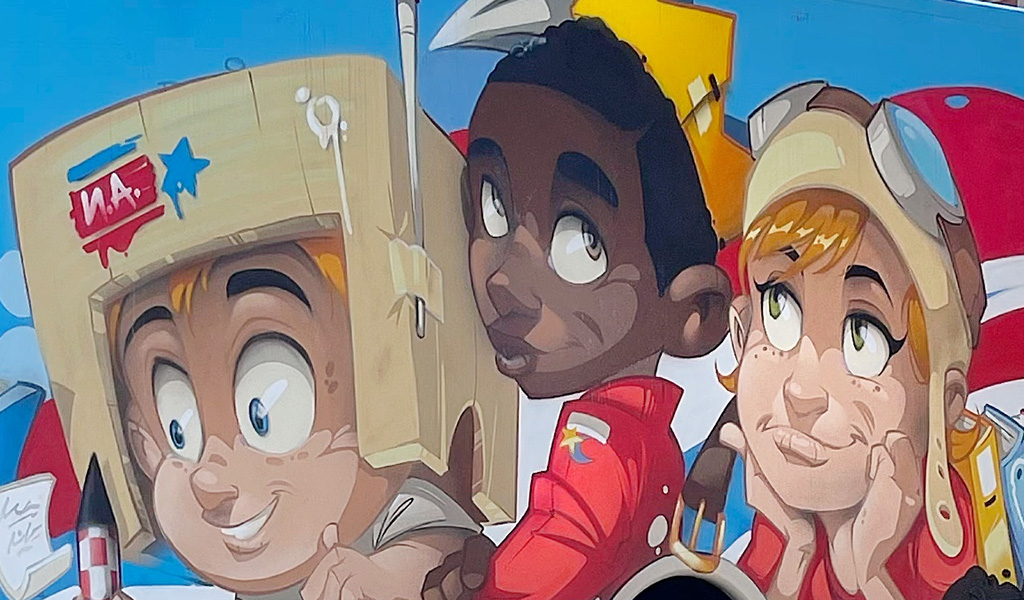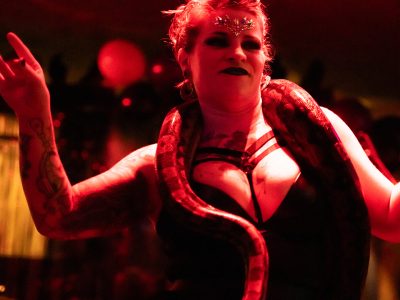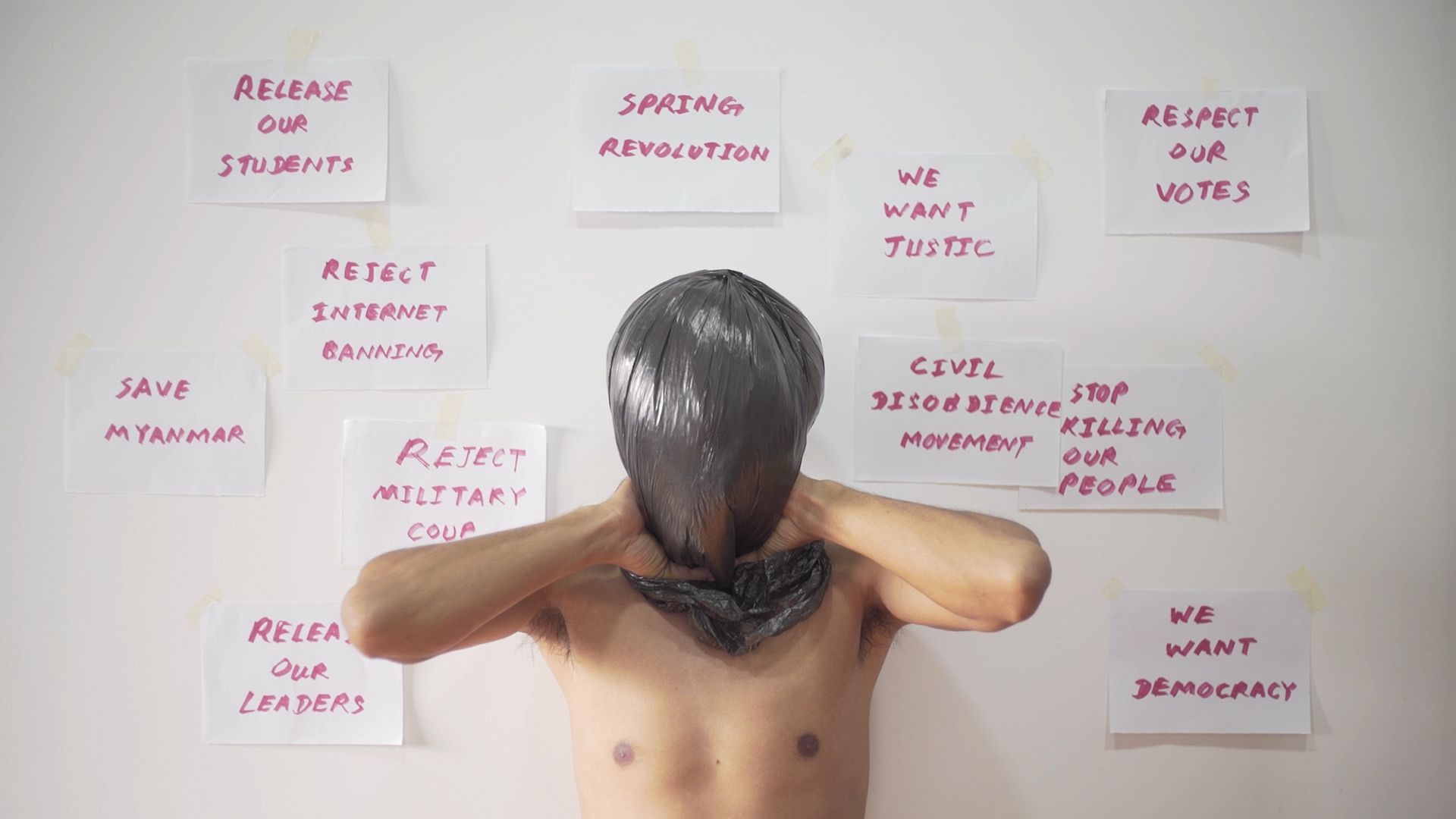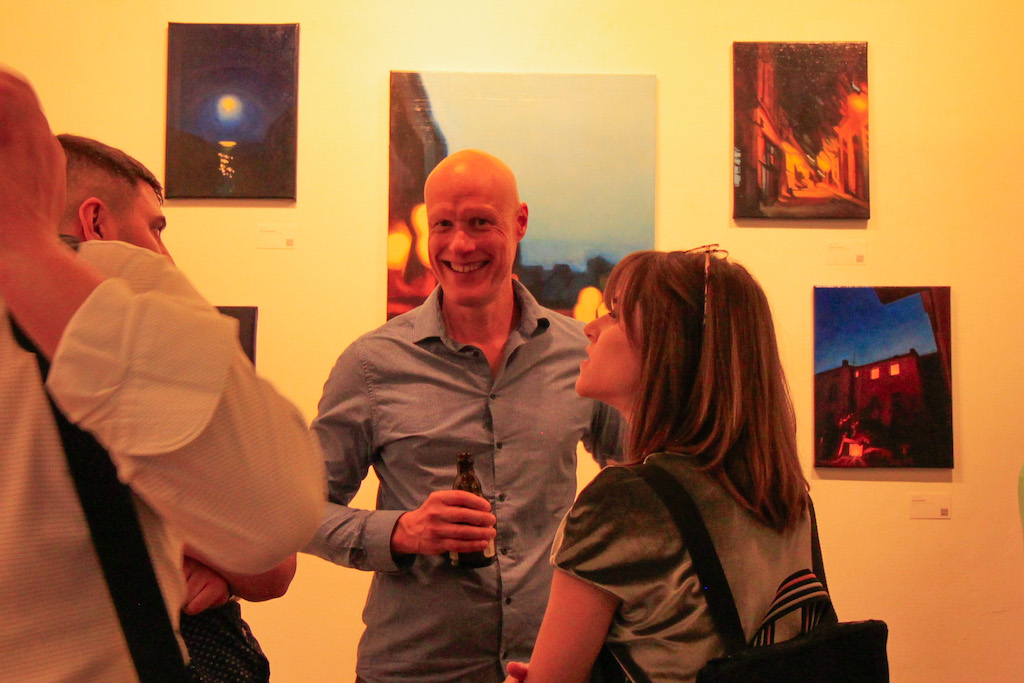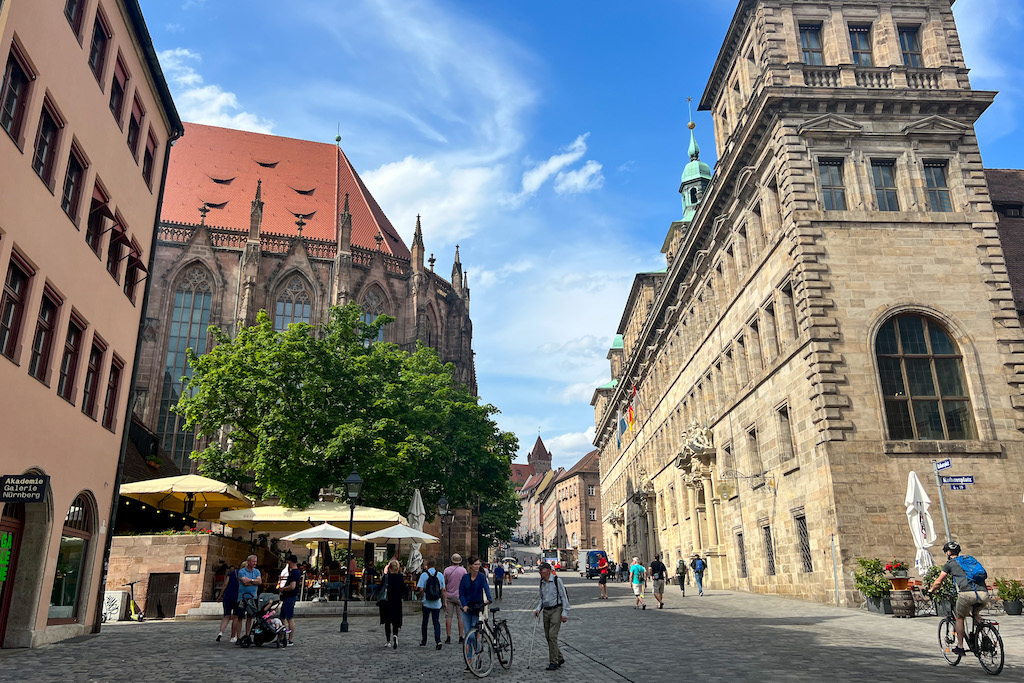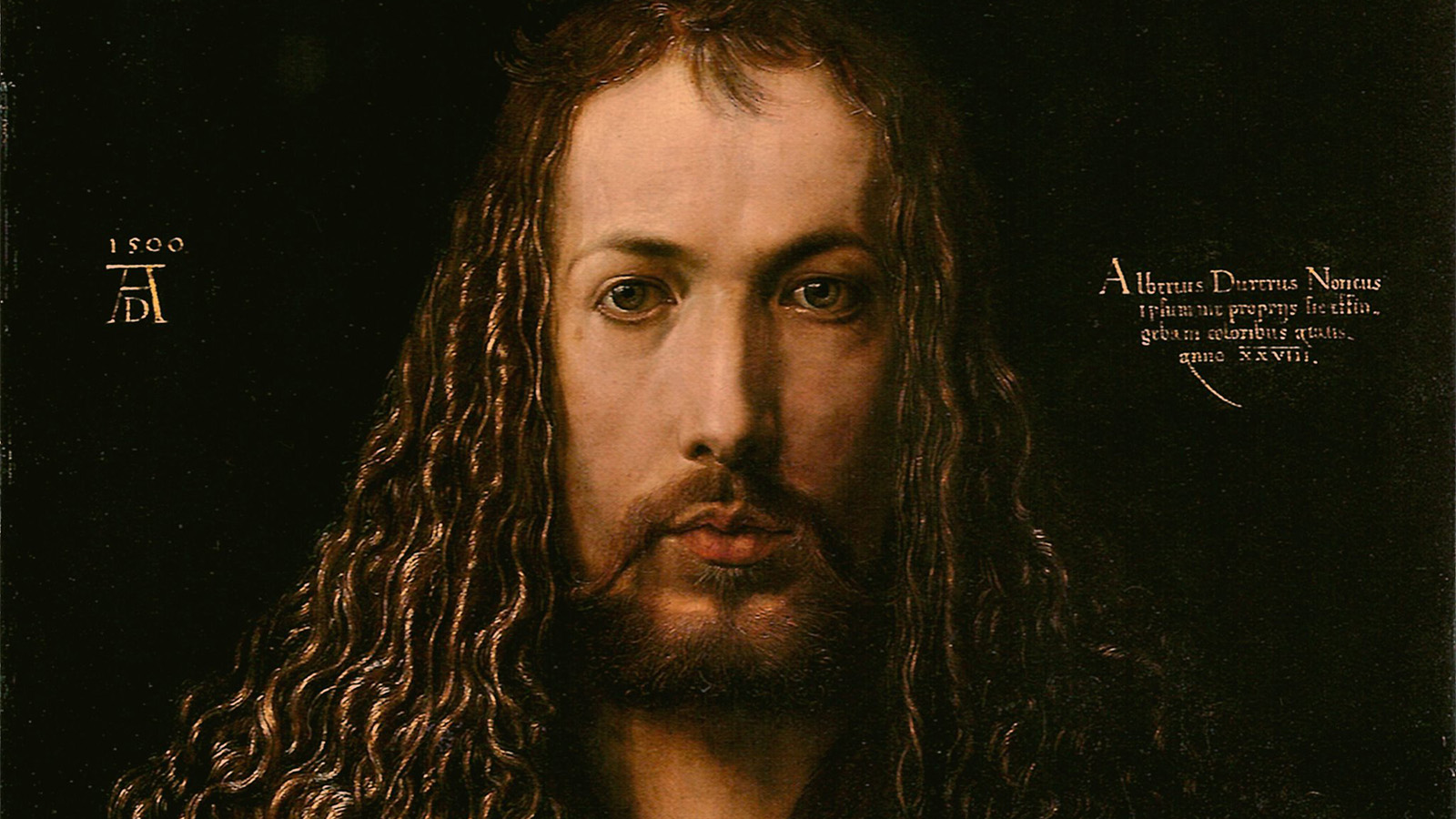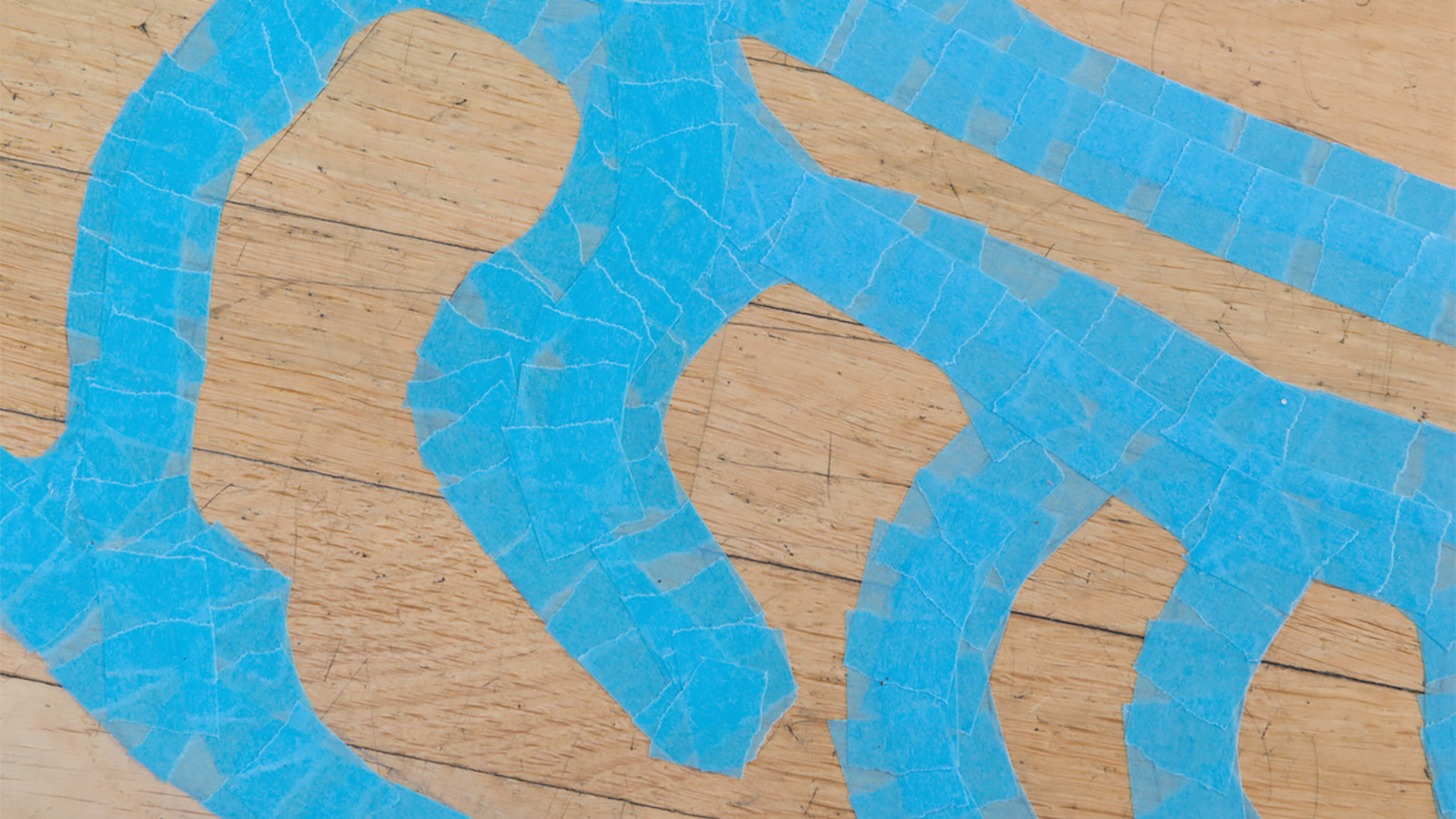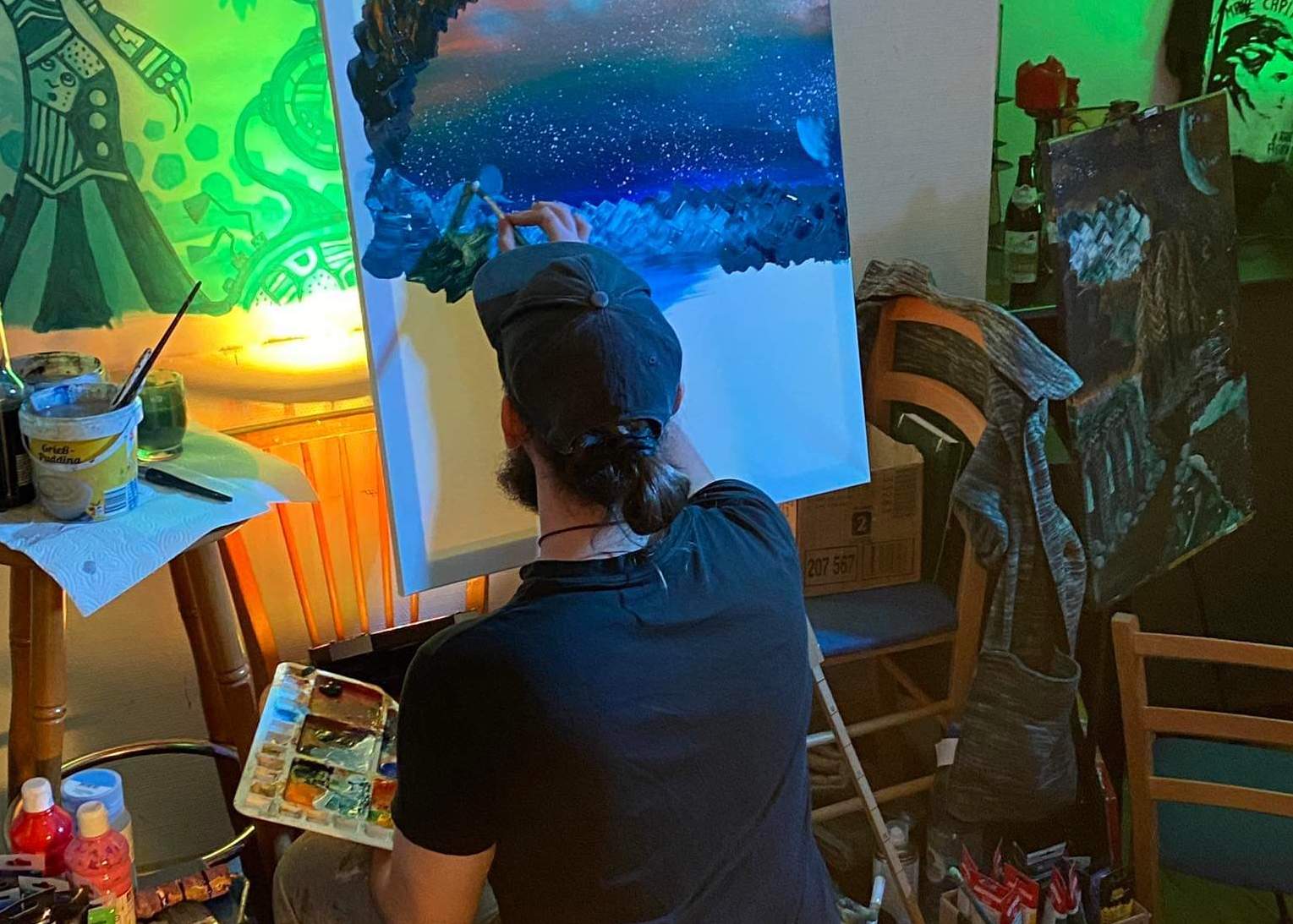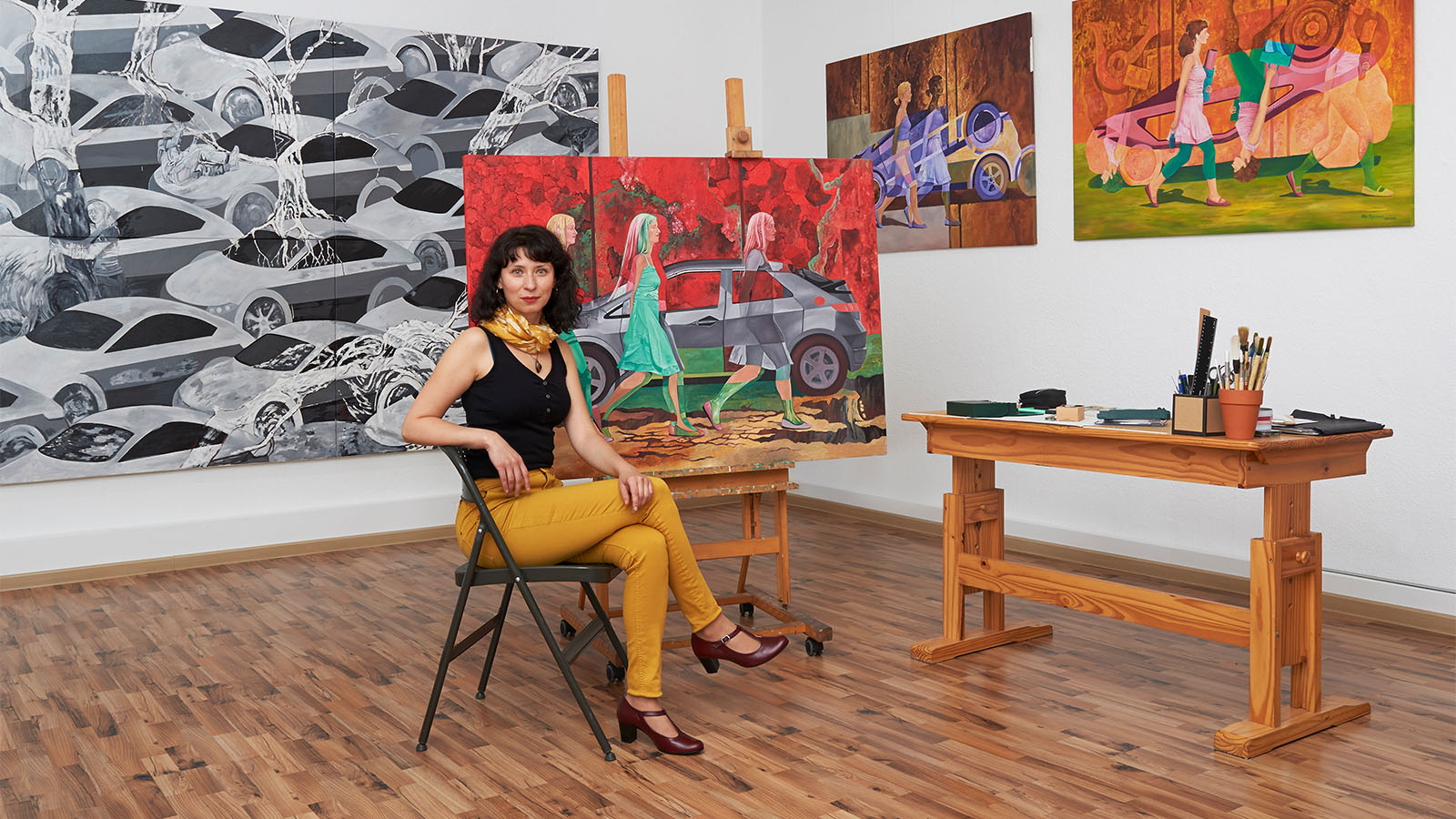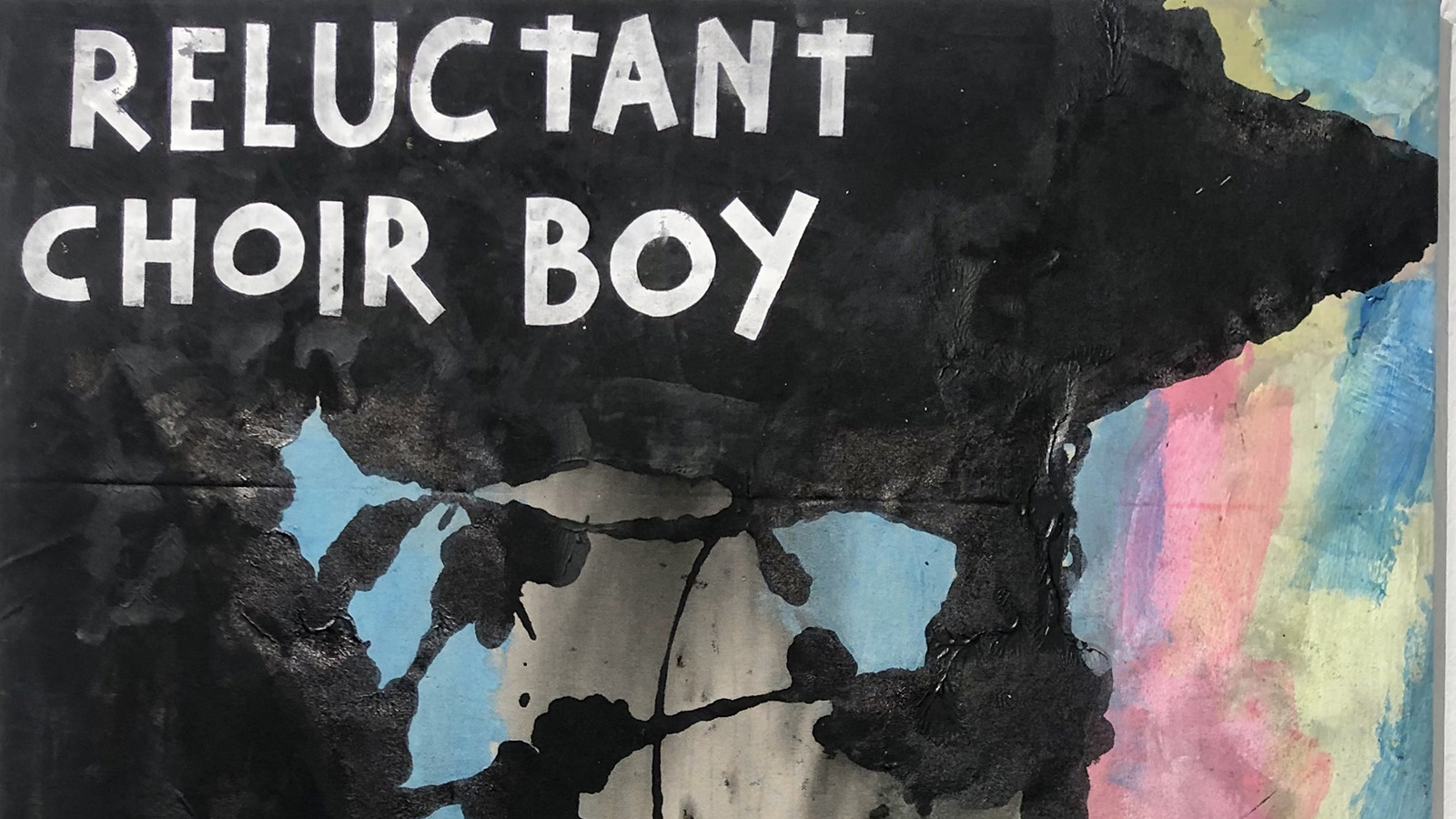The pandemic has forced us to change our everyday lives. While the world has never felt more physically isolated, many artists have found creative ways to make the most of their social media presence to exhibit, promote, and share their works. One such artist is Pablo Fontagnier, aka Hombre SUK and whose Instagram account is also his primary sales platform. I first became aware of Pablo when he was announced the winner of a competition to redesign a Nuremberg City Library reading bus for the library’s 650th anniversary. Furthermore, one of his motifs currently adorns the construction site fence (Bauzaun) in front of the Künstlerhaus/KunstKulturQuartier in Nuremberg. After checking out his Instagram account, my curiosity only grew more, and I needed to know more about Pablo Fontagnier and his graffiti-artist alter ego, Hombre SUK. So I requested an interview and, here I am, on a Sunday morning a few days later, sitting in his studio in the south of Nuremberg.
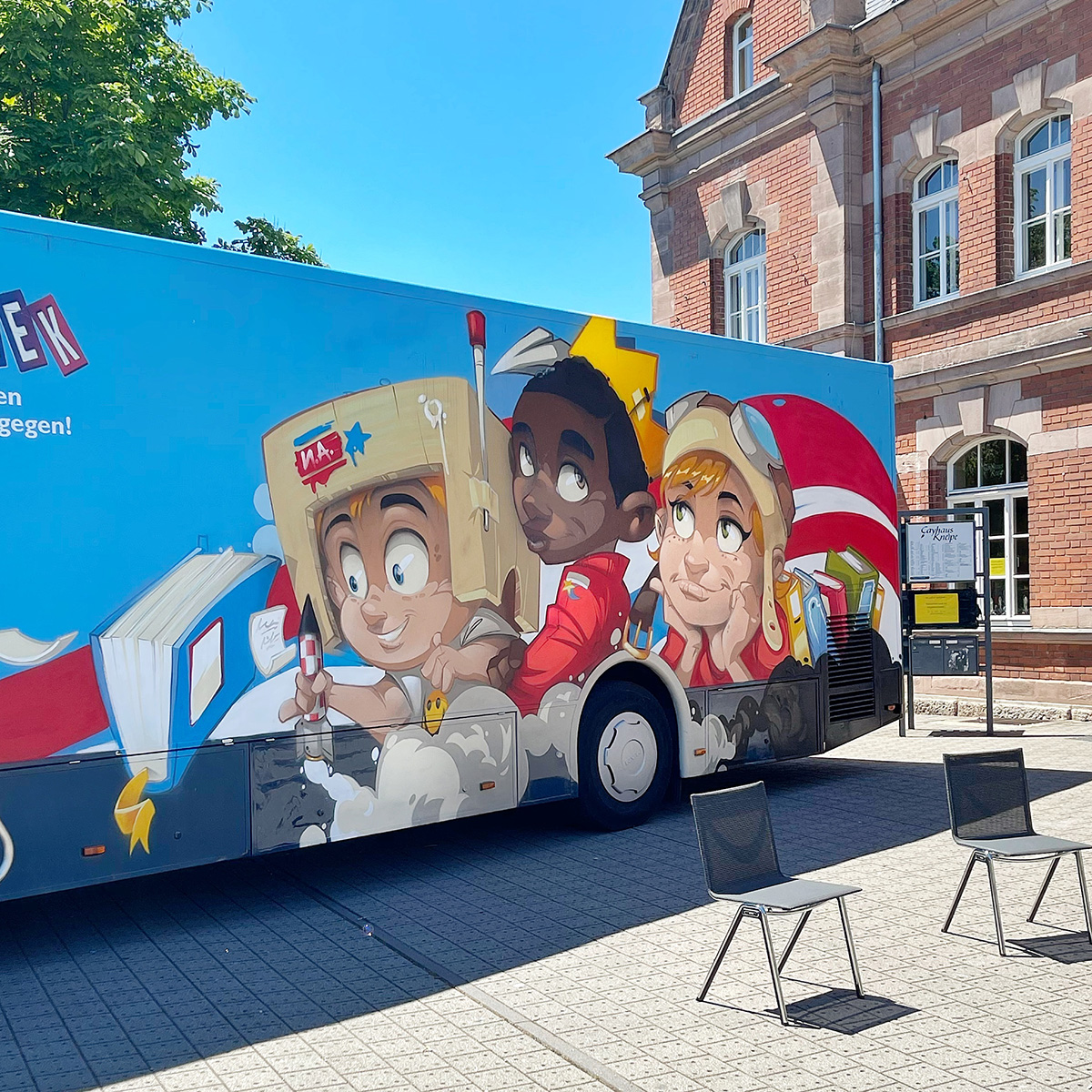
Bus of Nuremberg City Library – Street Art on Wheels © Hombre SUK
Lydia: Sorry for the slight delay, and thank you for taking the time for today’s interview, although you are looking after your son.
Hombre SUK: No problem. I have enough time today, and it’s nice that you are visiting me here today. Can I get you something to drink before we start? Coffee? Tea? Water?
Lydia: Water would be great, thank you. I thought that you could first go back to the beginning and tell me how you originally got into graffiti? That way, I can write down a few notes and then we can get back to the fifteen questions.
Hombre SUK: Fine, but if I am talking a mile a minute (laughs), you have to interrupt me.
Lydia: Don’t worry, I’ll do that. Thanks, so after this brief digression about your youth in Mannheim and your first attempts at graffiti (see the description at the end of this article), let’s go through the questions together.
Hombre SUK: Well, I’m ready.
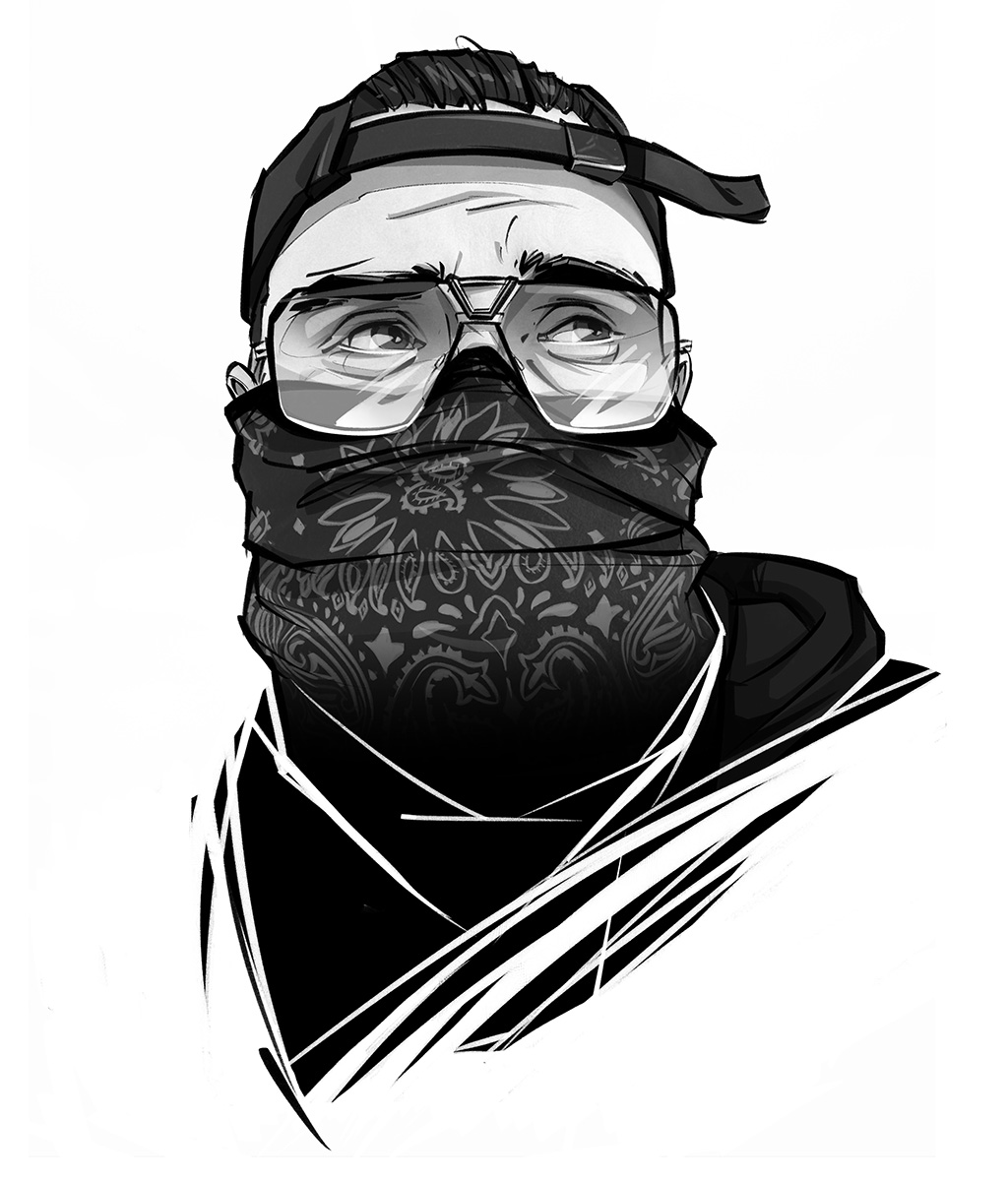
Portrait image in black-and-white © Hombre SUK
1) Are you a night owl or an early bird?
Hombre SUK: I am definitely a night owl. Days on which I have to get up before 8 a.m. or, even worse, at 7 a.m. in the morning, are like lost days. I just don’t work at such a time.
2) Where do you get your inspiration for your art from?
Hombre SUK: As simple as it sounds, my environment and my life inspire me. People, music, films, fashion. I reflect and sample what touches me and what I feel.
3) Do you have any artistic role models?
Hombre SUK: If we stay with graffiti art, then the helpers of my early days were clearly greats like CAN2 or MODE2. Today, Paco Sanchez or comic artists like Scottie Young or Brett Parson would be undeniable.
4) Do you get angry about criticism?
Hombre SUK: I don’t think anyone is free from criticism. But it definitely depends on WHO and especially HOW this criticism is presented. If I see something in it that I can grow from, then I welcome criticism.
5) What are you proud of?
Hombre SUK: I am proud of the good education and upbringing I received from my mother, which is reflected in my character and, therefore, also in my art. I was taught that you have to work for what you want and that you should remain modest, even and especially when you receive a lot of positive feedback from outside. That’s an image of mine that I often see confirmed and of which I am really proud.
6) Where would you like to be exhibited once in your lifetime?
Hombre SUK: I’ll just wait and see and let that happen when it happens. I don’t really have any goals in this regard.
7) What is your favourite place and your favourite part of town in Nuremberg?
Hombre SUK: I love to start my day with a walk around the Silbersee at the Dutzendteich. It’s completely unspectacular, but has become part of my daily routine and helps me start the engine slowly and focus before it starts.
8) What is your favourite dish?
Hombre SUK: Pizza, 100% Pizza!
9) What do you always have at home in the fridge?
Hombre SUK: Light. I always have a light in the fridge.
10) Who would you definitely not want to sit at a table with?
Hombre SUK: With myself on a bad day. I know my negative qualities well, regret my sometimes choleric and unreflective nature very much and quickly. But two of me at a table would certainly not end well.
11) What character traits do you appreciate or value in others?
Hombre SUK: I appreciate it when people value content more than outside appearance, the packaging and the presentation. The colourful, proud peacock… as the saying goes, is almost never as good as the sparrow in your hand – that is my experience. And if someone is really good at something, no matter what, then they don’t have to make a big fuss about it.
12) How do you relax?
Hombre SUK: Music. No matter HOW stressed or excited I am. Music brings me down, sometimes faster, sometimes slower.
13) Where is your next trip going to be?
Hombre SUK: I will stay in Germany for the rest of the year. It just doesn’t feel right to get on a plane at the moment, for all kinds of reasons. But I’m looking forward to some festivals in Munich, in Hamburg, in Goch and in Weißenburg.
14) What dream do you want to fulfil yourself?
Hombre SUK: I would like to do what I do at the moment as long as possible. To paint, draw, create and be able to shape my life from it, without great demands, but also without worries.
15) Life is too short to …
Hombre SUK: To search for meaning instead of giving meaning to it.
Lydia: I’ve so enjoyed talking with you and having a chance to learn more about your unique visual style.
Hombre SUK: Many thanks for your interest and attention!
Additional info about Pablo Fontaigner:
Pablo Fontaigner, aka Hombre SUK, was born on October 6th 1981, in Mannheim, where he spent his entire childhood and youth. Although he did not graduate from high school, he received a scholarship to the Academy of Communication in Mannheim, where he completed his training as a graphic designer focusing on illustration. Pablo Fontaigner keeps his personal and love life private. He only likes to emphasize his role, duties and responsibilities as a father. Since 2013, he has lived and worked in Nuremberg and is one of the most renowned graffiti¹ artists in the world. His passion for graffiti and street art started at the early age of 12 or 13 in the mid to late 1990s. Growing up in Mannheim’s graffiti and hip hop scene, he didn’t have much influence from other German taggers (more present in Berlin or Heidelberg). In retrospect, he considers this a great advantage because it allowed him to develop his own identity and unique style. From the very beginning, he painted almost exclusively figurative compositions – in other words: no letters, no style writing. A child of the ‘80s, his work was influenced by popular advertising, Disney-comic style and, of course, by the classic and groundbreaking video games of that decade like Donkey Kong or Super Mario. It’s no surprise then that graffiti quickly became the perfect form of expression for him. His artwork was, of course, also influenced by iconic graffiti artists like Atom One and Mode 2, just to name some really big ones.
Pablo Fontaigner created his alter–ego “Hombre SUK” during a period when he was often in Spain. Back then, he immediately fell in love with the country and the people’s mentality. Creating and finding his alter ego name was a combination of obeisance for the Spanish culture and a purely pragmatic choice of a stage name with easy to spray letters. Hombre is Spanish for “man”or dude, and the abbreviation SUK stands for the “Stick Up Kids” crew he belongs to.
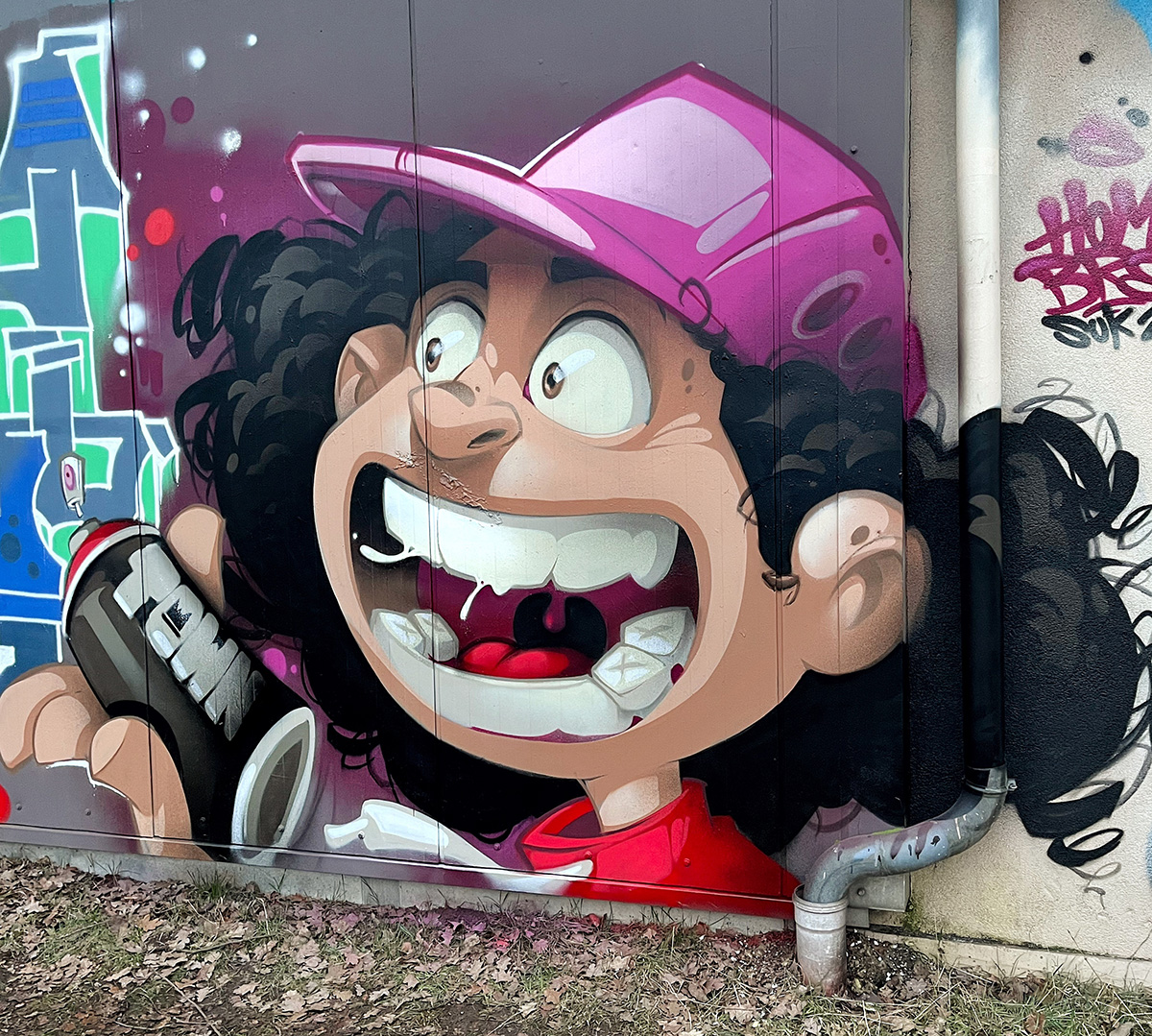
Smiling boy with big teeth © Hombre_SUK
Hombre has been active for almost twenty-five years and is primarily known for his cartoons and comic characters. Working exclusively with the can, his speciality is figure work, and semi-realistic sketches are the artistic elements. He developed his style through a lot of manual labour, and today Hombre sketches expressions and situations like no other. Working with spray cans suits him better than with a pen. With sure gestures, he draws and paints on paper as well as on the wall or a graphic tablet (he produces a lot of digital paintings and illustrations). When he is painting a large canvas or wall, he doesn’t work freestyle but transmits sketches developed on paper, computer or iPad free hand to an area upwards of 1.5 square metres. There is no upper limit, but small sizes are more of a problem. His canvas is the world, from house facades to advertising screens or a child’s room. He describes his style as typical old-school meets vector graphic with bright colours, hard contours and shadows. Black and very dark colours are relatively rare in his artwork.
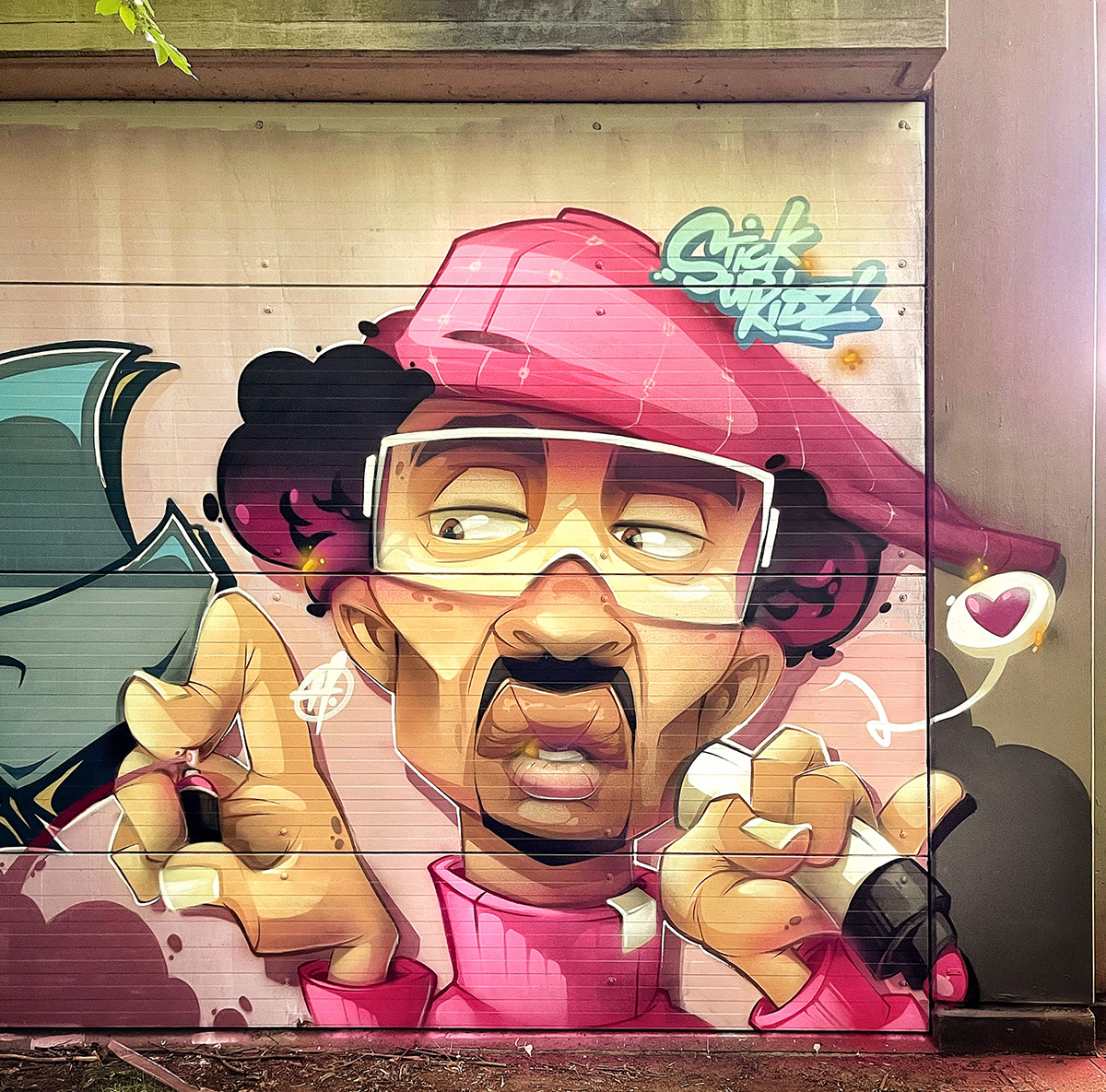
B-Boy in Pink © Hombre SUK
His art, inspired by everyday life and the people around him, is full of love and dedication down to the smallest detail. You not only see this authenticity in his drawings, you feel it too. Hombre’s work embodies innovativeness and street credibility, creating a cool, grungy, urban vibe that brings light to the streets and colour to grey concrete buildings. Recurring motifs are B–Boys² and B-Girls, Hip-Hop artists and gorgeous redhead women in Jessica Rabbit style. He rarely paints portraits of real people, and if he does so, it is mostly commissioned work. He is a founding member of the Mannheim TRS crew and has also been a member of the globally active Stick-Up-Kids³ for several years. Moreover, he is one of the leading character painters on the graffiti scene, both nationally and internationally. His work, including a wide variety of murals4, is present worldwide in Berlin, Bilbao, Mannheim, Moscow, and Zurich. Over the years, he has earned a good international reputation. In addition to large-format murals, he also designs the interiors of clubs, restaurants and cafes, or he beautifies food trucks. But glasses frames and pens are also part of his repertoire. For years he has designed for the fashion brand Pyromaniac Clothing, and in 2014 developed his own eyewear collection with the company Eschenbach. Despite his international bookings sometimes for large companies, Hombre keeps in touch with the scene, likes to attend spray jams and furthermore does many non-profit activities for social projects. Street art remains the heart of his work.
More about Hombre SUK graffiti artist, illustrator and product designer:
FB: https://www.facebook.com/hombreSUK/
Insta: https://www.instagram.com/hombre_suk_trs/
Arte report: https://www.arte.tv/de/videos/094401-003-A/5-minutes-with-hombre/
1. The word “graffiti '' is the plural form of the Italian word “graffito” which means “scratched”. Graffiti range from simple written words to elaborate wall paintings, and have existed since ancient times. Today graffiti art is hugely popular and some of the best known artists in the world are street artists. Still a lot of people claim that graffiti is not art at all and from the point of view of the government it is vandalism. If a person is caught making graffiti on a public or private building or in a public place without special permission, he or she may be fined or punished by law in some way. Therefore many graffiti artists choose anonymity as a way to prevent high fines or arrest. 2. The expression “B-Boys” and “B-Girls” are used for popular character motifs wearing special breakdance clothes like hoodies, street art hats, gold chains and extravagant sneakers. 3. The “Stick Up Kids (SUK)” is an international artistic group founded in 1993 by German graffiti artist Cantwo. 4. The word mural originates from the Latin word “murus”, meaning “wall”. A street art mural is a type of graffiti painted on a wall, ceiling, etc. Stylistically a mural will typically cover the entire wall, top to bottom. Street art murals can be inside a building or outside, in this last case they often decorate a degraded or an insignificant part of the city. Most mural artworks are done with permission, artists are recognized for it and are often well paid for their work. Usually, artists also sign the painting with their name. A definition of terms like “mural” or “mural art” is hard to pin down this is only an attempt to define this term. Like any other subculture the graffiti and street art scene has its own specific language and terms whose meanings change over the time.
Hashtags:
#art #arte #graffiti #hombre_suk #murales ‘muralart #stickupkids #streetart #sukcrew #urbanart


